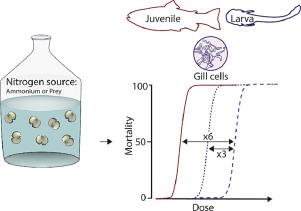Harmful Algae ( IF 5.5 ) Pub Date : 2020-09-29 , DOI: 10.1016/j.hal.2020.101905 Sofie Bjørnholt Binzer , Elisabeth Varga , Aaron John Christian Andersen , Daniel Killerup Svenssen , Lívia Soman de Medeiros , Silas Anselm Rasmussen , Thomas Ostenfeld Larsen , Per Juel Hansen

|
The dinoflagellate Karlodinium armiger has a huge impact on wild and caged fish during blooms in coastal waters. Recently, a new toxin, karmitoxin, was chemically characterized from K. armiger and a quantification method was established, thereby allowing investigations of the fish killing mechanism. K. armiger is not able to grow in standard growth media that are based on nitrate as a nitrogen source, and successful cultures of this species have only been achieved in mixotrophic cultures after addition of a prey source. Here we show that addition of ammonium (up to 50 µM) to the growth media is a good alternative, as K. armiger batch cultures achieve growth rates, which are comparable to growth rates reached in mixotrophic cultures. Karmitoxin production (1.9 and 2.9 pg cell−1 d−1) and cellular karmitoxin content (8.72 ± 0.25 pg cell−1 and 7.14 ± 0.29 pg cell−1) were in the same range, though significantly different, in prey-fed cultures and monocultures supplied with ammonium, respectively. Net production of karmitoxin stopped when the K. armiger cultures reached stationary growth phase, indicating no accumulation of karmitoxin in cells or growth media. Toxicity tests towards sheepshead minnow fish larvae indicated rapid death of the fish larvae when exposed to high K. armiger cell concentrations (LT50 of 2.06 h at 44.9 × 103 cells mL−1 cultivated with ammonium). Purified toxins caused the same physical damage to fish larvae as living K. armiger cultures. An exposure of purified karmitoxin to fish larvae and rainbow trout gill cells indicated that the fish larvae were about three times less sensitive than gill cells. When comparing the effect of purified toxins with the effect of whole K. armiger cultures, twice the toxin concentration of the purified toxins was needed to cause the same effect. Although a loss of karmitoxin of twenty percent was observed during the incubation, this could not explain the apparent discrepancy. Other factors, like a direct effect of the K. armiger cells on the fish larvae or other, yet unknown toxins may influence the effect of whole cell cultures. To study the effects of released karmitoxin, fish larvae were exposed to a K. armiger culture that was treated with HP-20 resin, which adsorbs extracellular karmitoxin. The 24 h HP-20 treatment resulted in a K. armiger culture that had 37% less total karmitoxin, without a reduction in cell concentration, and a reduced toxic effect was observed in the HP-20 treated culture, as compared to non-treated controls. Fish larvae that were exposed to HP-20 treated culture were immobilized, but survived during the 12 h exposure, whereas the exposure to non-treated culture led to high mortality of the fish larvae. Direct observations under the microscope revealed no evidence of micropredation of K. armiger on the fish larvae during any of the exposures. Thus, the results presented here, indicate that released karmitoxin is the main cause for fish kills by K. armiger. Finally, we found that juvenile rainbow trout were six times more sensitive than fish larvae towards K. armiger, indicating that juvenile fish are more sensitive to K. armiger in bloom situations than early larval stages.
中文翻译:

Karlodinium armiger产生的Karmitoxin以及K. armiger和karmitoxin对鱼类的影响
在沿海水域盛花期,甲鞭毛衣藻对野生和网箱鱼类有巨大影响。最近,一个新的毒素,karmitoxin用化学方法从表征K.蝠,并建立了量化方法,从而使鱼杀害机制的调查。棉铃虫不能在基于硝酸盐作为氮源的标准生长培养基中生长,并且仅在添加猎物源之后在混合营养培养中成功实现该物种的成功培养。在这里,我们表明,向生长培养基中添加铵盐(最高达50 µM)是一个很好的选择,例如K. armiger分批培养的生长速率可与混合营养培养的生长速率相媲美。在猎物喂养的培养物中,karmitoxin的产生(1.9和2.9 pg细胞-1 d -1)和细胞karmitoxin含量(8.72±0.25 pg细胞-1和7.14±0.29 pg细胞-1)在相同范围内,尽管差异很大。和分别向铵盐供应的单一文化。净产量karmitoxin的停止时K.蝠培养物达到稳定生长期,这表明在细胞或培养基没有karmitoxin的积累。对羊头min鱼幼虫的毒性试验表明,当暴露于高浓度的棉铃虫细胞中时,该幼虫迅速死亡。在44.9×10 3个 细胞mL -1下用铵培养2.06小时中的50个。纯化的毒素对鱼类幼虫造成的物理损害与生存的K. armiger养殖相同。纯化的卡莫毒素对鱼幼虫和虹鳟g细胞的暴露表明,鱼幼虫的敏感性比g细胞低约三倍。当比较的纯化毒素与整体的效果的效果K.蝠培养,需要纯化的毒素的毒素浓度的两倍,以使相同的效果。尽管在孵育过程中观察到了20%的卡莫毒素的损失,但这不能解释明显的差异。其他因素,例如K. armiger的直接影响鱼幼虫上的细胞或其他未知毒素可能影响全细胞培养的效果。为了研究释放karmitoxin的效果,仔鱼暴露于K.蝠,将其用HP-20树脂,其吸附胞外karmitoxin处理的培养物。24小时的HP-20处理导致了K.armiger与未处理的对照相比,在HP-20处理的培养物中观察到总karmitoxin减少了37%,而细胞浓度却没有降低,并且毒性作用降低了。暴露于HP-20处理的培养物中的鱼幼虫被固定下来,但在暴露12 h期间存活下来,而暴露于未经处理的培养物中则导致鱼幼虫的高死亡率。在显微镜下直接观察没有发现的micropredation的证据K.蝠在任何暴露对鱼幼虫。因此,这里提出的结果,表明释放karmitoxin是主要的原因鱼类死亡由K.蝠。最后,我们发现幼年虹鳟对K. armiger的敏感性比鱼幼体高六倍,表明幼鱼在开花期比幼体早期对棉铃虫更敏感。









































 京公网安备 11010802027423号
京公网安备 11010802027423号